|
MAKING OUR CIRCLE by Virlana Tkacz |
"It all started when a Soviet engineer decided to straighten out the road. The old road curved in this one spot just outside the village. He decided that was dangerous. So he brought in a lot of people and tractors and started ripping right through the hill where in the old times we held round dances. They got only half-way through before all the machines they brought had broken. So they left it just like that - the earth all exposed, all torn up. And there's been trouble here ever since."
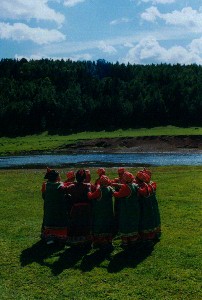
The woman shook her head so that the gold threads in her kerchief glistened in the gas-light. I sat mesmerized. "What kind of trouble?" I heard my friend Erzhena whisper. "Well... Last year one of the machinists was driving a tractor there and suddenly it just stops. This is a man who can fix anything, but nothing he tries helps. So he decides to walk to the village because it was getting dark. He takes only a few steps when he sees a flickering light. He walks towards it and sees it's a bonfire. And around the bonfire there are many dancers dancing a yoxor, just like in the old days. At first he is happy to see the dancers in the distance, but as he approaches he realizes that those are not people dancing, but spirits." "Oh, yo..." her neighbor exclained. The woman leaned into the light. "Let me tell you..." she started. I knew we were in for a good, long ghost story. The kind only the Buryats of Ust-Orda know how to tell.
A yoxor, or round dance in KhokhorskThe Buryats are the largest indigenous Asian population of the former Soviet Union. They live in three separate regions in Siberia. The largest is the Buryat Republic, which lies on the eastern shores of Lake Baikal. The Aginsk Buryat Autonomous Region lies two days drive to the east where the borders of Mongolia China and Siberia come together. The Ust-Orda Buryat Autonomous Region lies a solid day's drive to the west of Lake Baikal.
On my previous trips to Buryatia, I had worked at the National Theatre in Ulan Ude the capital of the Buryat Republic. In 1997 I first traveled to the Aginsk Region, where we collected folk songs and legends for our piece Flight of the White Bird. The following year we performed our piece at the National Theatre and then toured the remote villages of the Aginsk Region where we originally collected the songs that inspired this work. But I had never been to area west of Lake Baikal.
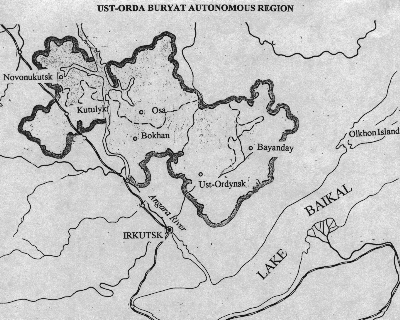
We were invited to Ust-Orda by Ludmila Oshirova, the head of the regional Committee on Culture. The area is know as the homeland of shamanism. Most Buryats adopted Buddhism in the 17th century, although they continued to hold with their ancient belief in shamans. The Buryats of Ust-Orda, however, were only shamanists. It is believed that they preserved the oldest forms of this ancient way of worship until the Soviet era. With the demise of the Union there has been a resurgence of Buryat culture throughout Buryatia and a revival of interest in shamanism.
Ms. Oshyrova wanted us to get to know all the districts of this unique land. The Ust-Orda Buryat Autonomous Area is made up of six districts (see map). Two are west of the Angara River and four are to the east. Since the Angara was dammed in the 1950s, it has flooded a large part of its basin, spreading so wide that the locals refer to it as the Angara Sea. We started our expedition in the two districts that are located west of the Angara: Nukuty and Alar.
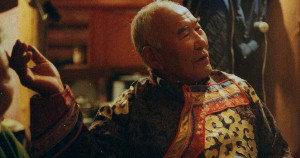 Singing the praise of the Geser in Buryat Yanguty
Singing the praise of the Geser in Buryat Yanguty
The first village we visited in Nukuty was Khadakhan, home of one of the richest farm collectives in the area. We were guest of the Culture Club which arranged for us to listen to several of the village elders recite epic tales, sing songs celebrating the deeds of the Geser and stump us with traditional puzzles. We also watched the youth group perform original dances and attempt a yoxor with their elders. After a brief ritual with a local shaman, we were treated to a traditional dinner and introduced to the complex customs governing drinking and toasting in this area. Later that afternoon we visited a private home in the village of Zakuley. There we recorded a woman who for many years headed the local folk ensemble. We also met the woman who had collected all the exhibits for the local ethnographical museum. She showed us many interesting items including a carved wooden calendar.
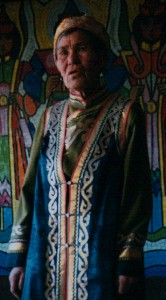 Singing the praise of the Geser in Khadakhan
Singing the praise of the Geser in Khadakhan
Our cultural exchanges were never one way. In each village my colleagues Sayan and Erzhena Zhambalov would pull out their guitar and sing the songs that have made them the most popular Buryat singers of their generation. Then they would sing the traditional songs we learned on our previous expeditions. This would prompt the elders to remember other long-forgotten tunes. Some of our best finds were a result of this less formal exchange.
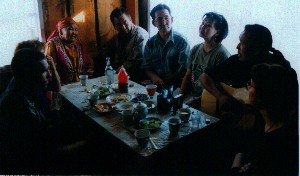 Sayan and Erzhena Zhamablova sing in Onhon
Sayan and Erzhena Zhamablova sing in Onhon
We spent the longest time in the Alar District. This area is known for its unique renditions of the yoxor, or round dance. The Alar yoxor is much slower than the others. At first it also seems melodically much simpler, but then you realize that its beauty lies in its half and quarter tones, so difficult for western-trained musicians to repeat. Here we heard the beautiful and haunting "Bride's lamet." In our show the spirits would sing it as they come to take away the bride.
Bright and beautiful is my face... is my face
Oh, silver or gold they cannot compare... they cannot compare
translated by Sayan Zhambalov, Virlana Tkacz and Meredith Wright

Elizaveta Igorova of Bakhtay sang us some of the most memorable yoxors we heard on our trip. She also was the first to show us a traditional heirloom coral necklace. Most of the traditional jewelry in this area was destroyed in the 1930s. People even burned photographs of their parents dressed up in traditional wear, so that they wouldn't be accussed of being anti-Soviet.
traditional coral necklaceAfterwards we drove to the regional center of Kutulik where a woman sang us many songs and then related her family story. She showed us documents she recently received detailing her father's arrest and execution in 1937. People who lived in Siberia suffered greatly during purges that racked Russia. Any practitioners of traditional culture were particularly vulnerable.
Next day in Kuita we heard beautiful songs and great stories about local shamans from the elders who gathered in a schoolroom. Some shaman stories they related took place in mythic time, others in their own lifetimes. After lunch we drove to Nygda, where two women told us the best ghost stories I have ever heard. Our theatre piece Circle was based on one of the stories that made our skin crawl that night.
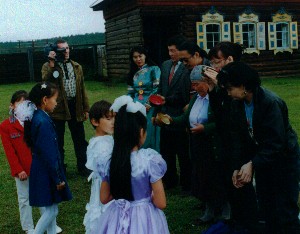 We are made Honorary Citizens of the village of Nagalyk
We are made Honorary Citizens of the village of Nagalyk
After our stay in the Alar District, we traveled to eastern half of Ust-Orda - to the regions: of Bayanday, Bokhan, Osa and Erkhirit-Bulagat, which are located between the Angara and Lake Baikal. There are several ferries that cross the Angara, but most people feel it's safer to drive all the way to Irkutsk and cross the Angara on a bridge. This is what we did. We stopped in Ust-Ordinsk, the capital of the Ust-Orda Region that night and met the woman who had arranged our trip. Ludmyla Oshyrova was a gracious hostess who wanted to hear about everyone we had met and everything we had seen. We visited her family and met Baba Sara, who told us many interesting traditional tales, as well as fascinating stories about meeting Japanese prisoners of war in her village when she was a child.
Next day we drove to the Bayanday district, where after meeting the local cultural officials, we drove with a shaman and his wife to the village of Nagalyk. The entire village was waiting for us dressed to the T -- we had been named Honorary Citizens of the Village of Nagalyk. We were greeted in the traditional way with bowls milk. Before drinking it, you must first let the milk drip to the ground as an offering to the spirits. The villagers then performed an entire drama made up of several rituals which they staged in a traditional wooden round house. During the show they cooked a meal of boiled lamb and noodles over a fire. The audience and the performers were treated to the food after the show. At the end of the day the villagers showed us different round dances. The show, the meal and the dance were directed by the village matriarch. She was the proud owner of a gorgeous traditional costume that included a medallion with an 18th century gold coin in its center.
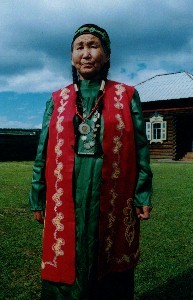 Matriarch of Nagalyk displays her traditional wear
Matriarch of Nagalyk displays her traditional wear
In Bokhan we first visited with the cultural officials. Afterwards we drove to village of Khokhosk, where the local folk ensemble greeted us with bowls of milk at the Culture Club. Because the weather was glorious the group decided to perform outdoors near the river. These elderly women proved to be the best yoxor dancers we would see. We stayed in Bokhan that night and next morning drove on to the Osa region. There we visited the village of Bilchir, where the famous Buryat ethnographer M.N. Khangalov first collected folk material at the turn of the century. In the village of Khokta we met a woman who was 108 years old. She told us some very funny stories and introduced us to her own granddaughter's granddaughters. In the village of Onhoy we were able to record many songs from a woman with a great repertoire. Late that night we stopped in Buryat Yanguty to record a man who was known throughout the region for his songs. He lived with his wife in a traditional round house and showed us how he made home brew.
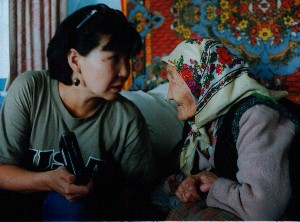 Erzhena interviews a woman who is 108 years old.
Erzhena interviews a woman who is 108 years old.
The last region we visited was the Erkhirit-Bulagat. The area is known for the wild tempo of its yoxors. The villagers of Olzony did not disappoint us. Their songs were perhaps the most memorable dance tunes we heard. Our last day in Ust-Ordynsk we spent with our hostess, Ludmyla Oshyrova, who arranged for a private tour of the local ethnographic museum which houses many exhibits from Paleolithic sites that were uncovered in the area. The museum is also known for its displays of traditional costumes and sacred objects that once belonged to shamans. Our guide was very knowledgeable about all aspects of Buryat culture and we were allowed to take pictures of the exhibits.
Olkhon, which is an island on Lake Baikal, is not part of the Ust-Orda Buryat Area. Officially, it is a separate district within the Irkutsk province. However, the Olkhon is the spiritual center for western Buryats and no trip to the Ust-Orda would be complete without a stop there. To get to the island we drove past Mount Yord where for centuries Buryats danced a great yoxor once a year. They say over 800 dancers had to take part in the round dance to close the circle around the mountain. Just past Mount Yord, we caught the ferry to Olkhon, where we saw the remnants of the great wall built in the 7th century to keep out invaders. We found a place to stay in the village of Khuzhyr near in the bay where we saw the sacred Shaman Rock just as the sun set. Next morning we climbed out on to the Rock to see the caves that for centuries were the most holy place in Buryatia. That afternoon we visited several old ladies in the neighboring village who told us many stories about this place.
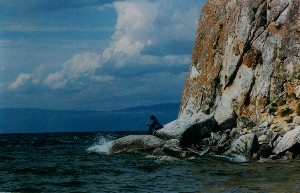 The author on Shaman's Rock
The author on Shaman's Rock
Our theatre piece Circle incorporates the stories, songs and ritual dances we collected in Ust-Orda. It was created in rehearsals with Yara actors and Buryat artists at La MaMa Theatre. Writer Sayan Zhambalov worked with me on the texts and translations for the piece. Composer Erzhena Zhambalov worked with musician Battuvshin and singer Badmahanda Aiusheyeva, as well as the many singers in the cast. There were also scenes with the Gypsy punk band Gogol Bordello. Circle premiered at La MaMa Annex March 25 to April 9, 2000.
BRAMA, Inc.
Copyright (c)1995-2000 Yara Arts Group; all rights reserved. Photos by Alexander Khantaev
|